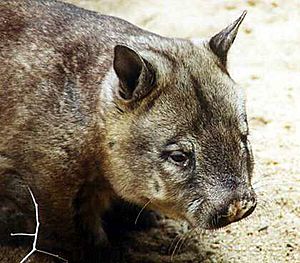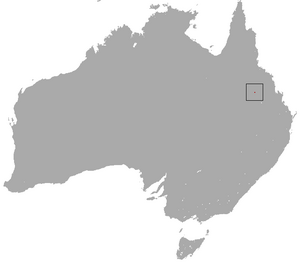Northern hairy-nosed wombat facts for kids
Quick facts for kids Northern hairy-nosed wombat |
|
|---|---|
 |
|
| Conservation status | |
| Scientific classification | |
| Kingdom: | |
| Phylum: | |
| Class: | |
| Infraclass: | |
| Order: | |
| Family: | |
| Genus: |
Gray, 1863
|
| Species: |
L. krefftii
|
| Binomial name | |
| Lasiorhinus krefftii (Owen, 1873)
|
|
 |
|
| Northern hairy-nosed wombat range | |
The northern hairy-nosed wombat (Lasiorhinus krefftii) is a special type of wombat. It's one of only three kinds of wombats still alive today. This animal is one of the rarest land mammals in the world. It is considered critically endangered, meaning it's in great danger of disappearing forever.
About 100 years ago, these wombats lived across New South Wales, Victoria, and Queensland in Australia. Today, they are found in only one main place: Epping Forest National Park in Queensland. This area is about 3 square kilometers (1.2 square miles) within the larger 32-square-kilometer (12 square miles) park.
In 2003, there were only 113 northern hairy-nosed wombats left. Only about 30 of these were females that could have babies. By 2013, the population grew to 196 wombats. An extra 9 wombats were moved to a special safe place called the Richard Underwood Nature Refuge near St. George. The good news is that the population has been slowly growing. In 2015, there were an estimated 230 individuals.
Contents
About the Northern Hairy-Nosed Wombat
All wombats are strongly built animals. They have big heads and short, powerful legs. They use their strong claws to dig burrows, which are underground tunnels where they spend most of their time. A wombat can dig a new burrow in about a day.
Northern hairy-nosed wombats have soft, grey fur covering their bodies. What makes them special is the fur on their noses, which is different from the common wombat. They also have longer, more pointed ears and a wider snout. These wombats can grow to be about 35 centimeters (14 inches) tall and up to 1 meter (3.3 feet) long. They can weigh up to 40 kilograms (88 pounds). Female wombats are usually a bit bigger than males because they have an extra layer of fat. They are slightly larger than the common wombat and can have babies a bit faster. On average, they give birth to two young every three years.
The wombat's nose is very important because they have poor eyesight. They rely on their strong sense of smell to find food in the dark. Scientists have also found that their digestive system is amazing. It can turn liquid waste into cube-shaped droppings!
Wombat Behavior and Life Cycle
The northern hairy-nosed wombat is a nocturnal animal. This means it is active at night. During the day, it lives underground in a network of burrows. They stay in their burrows during bad weather. This is because their burrows keep a steady temperature and humidity. Wombats have been known to share burrows with up to 10 other wombats, with an equal number of males and females.
Baby wombats are usually born during the wet season, which is from November to April. When there is a lot of rain, many female wombats (50-80%) will have one baby at a time. Young wombats stay in their mother's pouch for 8 to 9 months. They stop drinking their mother's milk when they are about 12 months old.
These wombats can go without food for several days if food is hard to find. This is thanks to their fat reserves and slow metabolism. Even when they eat every day, they only feed for about 6 hours in the winter and 2 hours in the summer. This is much less than a kangaroo of the same size, which eats for at least 18 hours a day.
Their diet includes native grasses like black speargrass (Heteropogon contortus), bottle washer grasses (Enneapogon spp.), golden beard grass (Chrysopogon fallax), and three-awned grass (Aristida spp.). They also eat different types of roots. Their teeth keep growing throughout their lives. The tough grasses they eat help wear down their teeth.
Unfortunately, their habitat has been taken over by African buffel grass. This grass was brought in for cattle to eat. It grows much faster than the native grasses that wombats prefer. This means wombats have to travel further to find their favorite food. This also leads to less food being available for them.
Wombat Family Tree
Naming the Wombat
The scientific name for the northern hairy-nosed wombat's group is Lasiorhinus. This name comes from Latin words. Lasios means hairy or shaggy, and rhinus means nose. The common name, "northern hairy-nosed wombat," describes where they used to live (in the north) and the fur on their nose. Sometimes, older books might call it the Queensland hairy-nosed wombat.
How Wombats are Related
The northern hairy-nosed wombat belongs to the same group (genus) as one other living species, the southern hairy-nosed wombat. The common wombat is in a different group called Vombatus. Both Lasiorhinus species look different from the common wombat. They have silkier fur, wider hairy noses, and longer ears.
The koala is the closest relative to wombats among all marsupials. They are both in the same larger group called Vombatiformes.
Protecting the Northern Hairy-Nosed Wombat
The northern hairy-nosed wombat faces many dangers. These include having a very small population, being hunted by predators, not having enough food, diseases, floods, droughts, wildfires, and losing their homes. Because there are so few of them and they live in such a small area, natural disasters can be very harmful to them.
Historically, both main groups of hairy-nosed wombats faced population drops between 1870 and 1920. This was mainly due to not enough food, competition with other animals, and predators. Wild dogs are the main predators of wombats. Rabbits and actions by landowners have also caused wombat numbers to go down. Controlling rabbits in ways that don't harm wombats can help protect them. The habitat at Epping Forest National Park is now well-protected to give these wombats a better chance to survive.
Because of these threats, the northern hairy-nosed wombat is listed as "endangered" by the Australian government. The IUCN also lists it as "critically endangered".
Their main home is only about 300 hectares (750 acres) within the Epping National Forest. This park is in east-central Queensland, about 120 kilometers (75 miles) northwest of Clermont.
In 2003, scientists studied the wombat population. They used special tape in burrows to collect wombat hair. By studying the DNA from the hair, they learned that for every 113 wombats, there were about 30 females for every 100 males. This information helps researchers understand the population better. It also helps them figure out why there are more males than females in the wild.
There have been two cases of male northern hairy-nosed wombats getting a fungal infection. This infection comes from a fungus found in the soil. It's likely the wombats breathe in the fungus from the ground. These cases give important information on how to prevent more deaths.
Many conservation projects have started to help this species. For example, in 2000, a two-meter-high (6.6 feet) fence was built around 25 square kilometers (9.7 square miles) of the park. This fence helps keep predators out.
A second group of these wombats was started in 2008. This "insurance colony" is at the Richard Underwood Nature Refuge. It is also protected by a predator-proof fence. At Epping Forest National Park, more money and attention have been given to wombat research. This includes watching the population, managing fires, keeping the fence in good shape, controlling predators and competing animals, and removing invasive plants.
The species recovery plan from 2004 to 2008 also focused on getting the community involved in saving the species. It aimed to increase the wild population and create other populations in areas where wombats used to live. It also worked with zoos to start a breeding program. A volunteer caretaker program allows people to help monitor the wombats and keep the fence repaired. Finally, DNA fingerprinting of wombat hairs means scientists can study them without having to trap or track them. Because of all these efforts, the northern hairy-nosed wombat population is slowly getting bigger.
Related Pages
See also
 In Spanish: Wombat del norte para niños
In Spanish: Wombat del norte para niños


